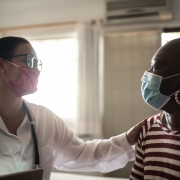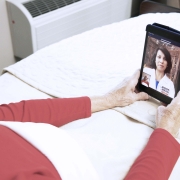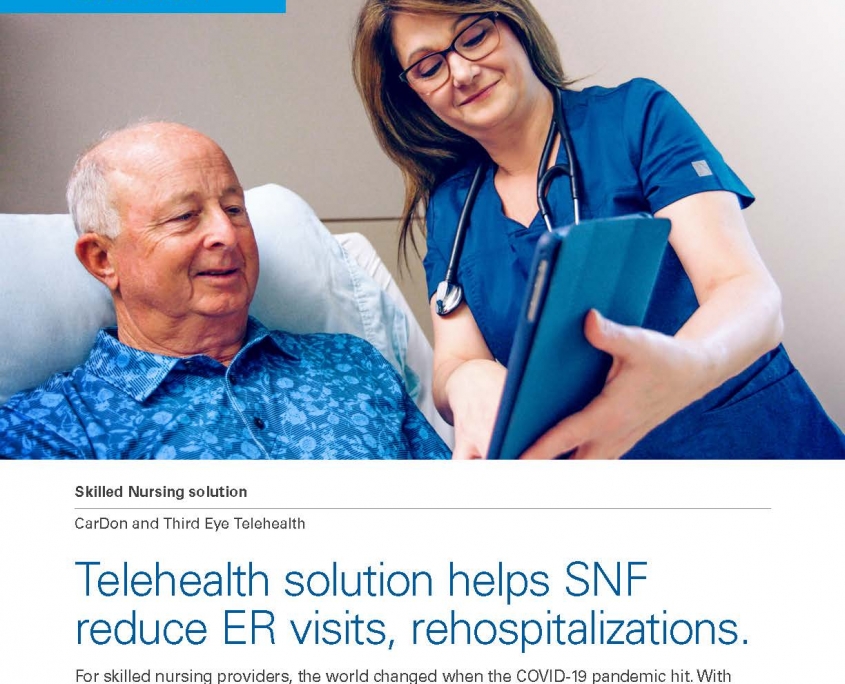About ITEX
ITEX is the family-owned operator of Glenview Terrace, Harmony and Whitehall of Deerfield. They are the market leader for post-acute rehab in the Chicago area. They are also in the preferred provider networks for some of the largest health systems in Illinois (Advocate Aurora Health, NorthShore University HealthSystem, and Northwestern Medicine). Third Eye Health’s telehealth solution has supported both ITEX and its network of skilled care centers in keeping patients in the same health system and avoiding leakage.
Pre-Third Eye Health Challenges
Known for delivering exceptional care in Chicago and throughout the North Shore, ITEX sought to improve the availability of providers during nights, weekends, and holidays. Their skilled nursing facilities were affiliated with a large clinically integrated network in Chicago and were finding it difficult to treat ITEX’s residents across a large geographic area. This was especially true as the 2020 pandemic set in and human resources became even more scarce. As a result, newly presenting changes in condition during periods when providers were on call on nights, weekends, and holidays, often led to either delays in care or patients being transferred to the ER, subsequently leading to unnecessary readmissions.
Timeliness to care is essential in matters of patient satisfaction, clinical outcomes, and minimizing the cost of care. In most scenarios, these readmissions were preventable had a provider been able to properly assess the patient and treat them in place. ITEX understood that while their care was highly regarded, there were still opportunities for improvement when it came to ensuring their residents receive the highest level of care possible.
With unnecessary readmissions being a significant driver in rising healthcare costs, the provider group collaborated with ITEX, seeking a solution to reduce these unnecessary readmissions and their associated costs. After-hours readmissions were on the rise with providers spread thin in their on-call capabilities. And without virtual access to the EHR, there was a lag in documentation and orders being signed, leading to further delays in care, worsening conditions, and transfers to the ER. Oftentimes transfers became readmissions that could have been prevented had a provider been able to treat the patient in place. Ian Crook, Chief Operating Officer for ITEX remarked, “Adopting a system-wide telehealth solution with the support of our providers was key to the success we experienced in increasing the quality of care for our residents.” Having used their services in other local SNFs throughout Chicago, the provider group was familiar with the impact of a well-known post-acute telehealth provider, Third Eye Health, and recommended ITEX consider adding their services for night, weekend, and holiday provider coverage.
Why Third Eye Health?
Many of the providers for the ITEX had already been familiar with Third Eye Health, the nation’s leading virtual care provider for post-acute, and had seen first-hand the benefits to patients, providers, and entire health systems when their services and technology were in play. One of the greatest observed benefits to providers being that high-acuity patients had access to quality care at all times of the day with Third Eye Health’s board-certified physicians taking call on nights, weekends, and holidays.
Through their telehealth technology, a Third Eye Health physician can be available to consult with the bedside nurse and resident within minutes. EHR-integration capabilities give Third Eye Health physicians visibility to patient medical records and the ability to add notes and signed orders. Secure video, text, and image sharing capabilities enable the Third Eye Health physicians to lay eyes on the patient, have in-depth conversations with both nurse and patient, assess lab reports and additional paperwork all with the use of a simple app on an iPad. Additionally, with Third Eye Health’s Care Coordination services, documentation of every Third Eye Health encounter is reviewed and summarized, then shared with the primary provider and nurse leaders, creating a warm hand-off in care before the next day begins.
For the provider group, bringing on Third Eye Health meant offering relief to their providers on nights, weekends, and holidays. In many instances, Third Eye Health physicians can respond faster and provide a much more thorough assessment using the secure, integrated technology than a provider could over the phone. Patients can receive high quality care from board certified physicians without being transferred to the ED. And by treating them in place, patients do not risk exposure to additional infections, worsening conditions, or the possibility of being moved to an entirely different facility following discharge. They remain in the same care and Third Eye Health’s Care Coordination Managers ensure that a full summary is provided after every encounter.
Another factor making Third Eye Health the ideal candidate to support ITEX’s clinical team in caring for residents was its ability to integrate with ITEX’s EHR, PointClickCare. Third Eye Health is unique in that all their technology is developed in-house. And so, by aligning with EHR’s, such as PointClickCare and MatrixCare, Third Eye Health is quickly and easily able to implement their services which facilitate bi-directional EHR-integration, enabling access to medical records for ITEX’s clinical team from Third Eye Health physicians and vice versa.
Implementation
ITEX saw many advantages in bringing on Third Eye Health as their virtual care provider. The implementation process was highly efficient and quick. In a matter of weeks every center was up and running. Several factors contributed to the quick-start capabilities of Third Eye Health.
“Third Eye Health’s technology and physician services fit within our pre-existing workflow, making it easy for our clinical teams to initiate virtual care consultations,” said Crook.
As already mentioned, Third Eye Health has an in-house development team and a pre-existing partnership with PointClickCare, expediting the EHR-integration into Third Eye Health’s proprietary telehealth technology. Next, Third Eye Health uses iPads to conduct their virtual bedside visits. Whereas most telehealth solutions use third-party carts, iPads are easily accessible and incredibly mobile, making it easy to travel from room to room with the nurses as they conduct their rounds. And since most nurses are familiar with using iPads, the technology was easy to learn. Third Eye Health works directly with the nurses and leadership in each center and offers training by experienced post-acute nurses. With iPads in hand, nurses could confidently begin consultations with Third Eye Health that same day.
The technology on the iPad is simple to use. With the tap of a button, nurses saw for themselves that they could connect with a physician within minutes. They could text, share photos, and video chat with physicians. And with the PointClickCare integration, all notes and orders were readily available in the EHR following each encounter.
Each center has a dedicated Third Eye Health Care Coordination Manager whose day begins at the end of day-shift by receiving a report from the center informing Third Eye Health of high risk patients, new admissions or any pertinent information the Third Eye Health physicians may need should they be called. Bringing the care full-circle, the Care Coordination Manager reviews each encounter and sends a summary immediately following a coverage period ensuring proper attention continues once the primary provider returns the next day.
Impact
Once implemented, utilization of Third Eye Health’s services created an immense impact on ITEX patients, providers, and clinical staff.
For patients, they could be seen by physicians with access to their medical records at any time, day or night. They were being treated in place, often preventing further complications to their condition and better clinical outcomes. As patients were able to see a physician when needed, patient satisfaction levels rose even higher.
Nurses had access to Third Eye Health physicians through easy-to-use mobile technology. They were no longer waiting for physicians to call back, or for orders to be signed. Third Eye Health physicians answered consultation requests, on average, in under two minutes. Physician notes and orders were available directly through their EHR. Administrators and Directors of Nursing benefited from the quality assurance of the Care Coordination Manager reviewing each encounter and from the detailed analytical reports made available through Third Eye Health’s technology. For them, there was an extra set of eyes looking out for regulatory matters and reducing risk.
For ITEX, more patients being treated in place meant that fewer patients were returning to the hospital. More beds were full and the amount of mandatory bed holds decreased. Less transfers to the ER meant fewer unnecessary readmissions, and a lower probability of patients being discharged elsewhere. And as clinical outcomes improved, they were regarded highly by local health systems in their ability to provide high quality care, deeming them a leading partner for post-acute care.
The provider groups serving ITEX also experienced a higher level of satisfaction by no longer taking calls. They were able to take much needed time to focus on their own health and well-being, and in turn, found themselves able to perform better at the bedside. Their Medical Director (who had been with ITEX for over 30 years) valued these benefits and used them as a large recruiting tool for the provider group, promising nights, weekends and holidays off – an anomaly when it comes to post-acute medicine.
From Ian Crook’s perspective, “Physician satisfaction rose once Third Eye Health began covering nights and weekends for multiple reasons. Fewer residents returning to the hospital sustained care continuity within our communities, dispelling leakage back into the health system. In finally having an opportunity to rest, interactions between providers and nurses improved, positively impacting the overarching quality of care for our residents. Most importantly, our providers had peace of mind knowing their patients have access to a dedicated group of physicians watching over their care on nights, weekends, and holidays.”
Lifetime Impact
4384 Consults
95% Treat In Place Rate
Treat in Place by Encounter Type
100% Treat in Place Rate for TOP 10 encounter types
The exception: high acuity conditions that should warrant a transfer to the ED in many cases, such as:
- Fall with Injury: 84%
- Hypoxia: 59%
- Chest Pain: 65%
Summary
It’s not surprising that Third Eye Health continues to be the leader in virtual care in the post-acute world. Their technology is easy to implement and even easier to use. With PointClickCare and MatrixCare integration and dedicated care coordination, all the guesswork is eliminated, supporting the primary clinical team through seamless transitions in care.
The quality of care received from Third Eye Health physicians complements that of the primary providers. By treating patients in place, clinical outcomes and quality measures improve.
What sets Third Eye Health above any other post-acute telehealth provider is its ability to provide integration at scale, essentially becoming a force multiplier in delivering high quality post-acute care: as care quality increases, so do outcomes, patient satisfaction, staff and provider satisfaction, as well, all while reducing the overall cost of care.
Download case study





